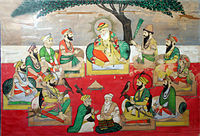A miniature painting, dated 1890, depicting an "imaginary portrait" of the
ten gurus and others.[1]
| Part of a series on |
| Sikhism |
|---|
 |
The Sikh gurus (Punjabi: ਸਿੱਖ ਗੁਰੂ; Hindi: सिख गुरु) are the spiritual masters of Sikhism, who established the religion over the course of about two and a half centuries, beginning in 1469.[2] The year 1469 marks the birth of Guru Nanak, the founder of Sikhism. He was succeeded by nine other human gurus until, in 1708, the Guruship was finally passed on by the tenth guru to the holy Sikh scripture, Guru Granth Sahib, which is now considered the living Guru by the followers of the Sikh faith.[3] The guruship was also passed onto the Guru Panth, consisting of the Khalsa, however this means of guruship went into decline following to rise of Maharaja Ranjit Singh.[4]
- ^ The Sikhs. E.J. Brill. p. 38. ISBN 9004095543.
- ^ Sen, Sailendra (2013). A Textbook of Medieval Indian History. Primus Books. pp. 186–187. ISBN 978-9-38060-734-4.
- ^ The Sikhs : faith, philosophy & folk. Lustre Press. 1998. ISBN 978-8174360373.
- ^ McLeod, W. H. (24 July 2009). The A to Z of Sikhism. Scarecrow Press. pp. 84–86. ISBN 9780810863446.
Guru Gobind Singh is traditionally believed to have announced that the personal transmission would end at his death, but that the mystical Guru would remain embodied in the scripture and the corporate Panth. ... GURU PANTH. The Guru Panth was a doctrine particularly suited to the circumstances of the 18th century, providing an effective means of decision making for Sikhs who were divided into several misls. When unification was achieved under Ranjit Singh the practice of eliciting corporate decisions from the Panth was discarded. The doctrine is still maintained today, and efforts are occasionally made to seek the Guru's will by this means. It is, however, seldom invoked. The voice of the Guru is much more commonly sought through the words of the Guru Granth.

